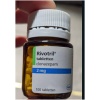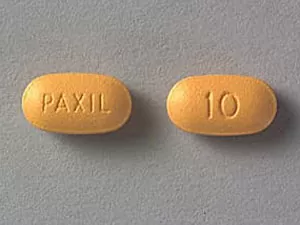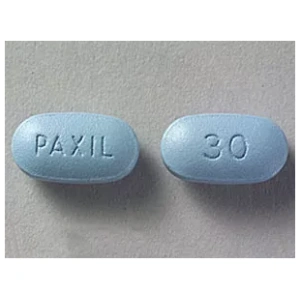Paxil 10 mg
$15.00
Paxil is an antidepressant in the selective serotonin reuptake inhibitor class. Doctors prescribe Paxil 10 mg to treat major depressive disorder. This medicine is available only with your doctor’s prescription for different uses. It is also used only to treat moderate to severe hot flashes caused by menopause.
It is important to keep all medication out of sight and reach of children. To protect young children from poisoning, always lock safety caps and immediately place the medication in a safe location one that is up and away.
Description
Paxil, Paxil CR, Brisdelle, and Pexeva are the Us brand name. This drug belongs to a group of drugs called selective serotonin reuptake inhibitors (SSRIs) used for the treatment of depression. It affects chemicals in the brain that may be unbalanced in people with depression, anxiety, or other disorders. You should not take Paxil 10 mg during working hours because it may make you drowsy and affect your working, judgment, and thinking. Ask your doctor about the safe use of alcoholic beverages while you are taking the medicine.
Forms And Doses Of Paxil:
People can use both immediate-release and controlled-release tablets for major depressive disorder.
Paxil is available in the following dosage forms:
- Table, Immediate Release
- Tablet, Extended Release
- Controlled-release tablet (Paxil CR)
- Capsule
- Suspension
The different dosages and strengths are available in different forms. Such as
- Paxil Immediate Release tablets in milligrams (mg) of Paxil 5 mg, 10 mg, 20 mg, 25 mg, 30 mg, and 40 mg.
- The oral suspension is available in milligrams per milliliter (mg/ml) 10 mg/5 ml.
- Paxil CR (controlled release) tablets are 12.5 mg, 25 mg, 37.5 mg.
Doctors will typically start adults on 20 mg of immediate release.
Immediate-release tablets:
Depending on the person’s response to Paxil, the doctor may increase the dose by 10 mg every week if needed. The maximum daily dose of Paxil is 40 mg for major depressive disorder in adults.
Controlled-release tablets:
The adult may begin on 25 mg once daily when using controlled-release tablets of Paxil. It starts at 12.5 mg once daily. Doctors may increase the dose by 12.5 mg every week, depending on the person’s response to treatment.
The maximum daily dose of Paxil CR in adults is 62.5 mg and 50 mg in older adults.
How Paxil 10 mg Works:
The active pharmacological ingredient is Paxil, an SSRI. SSRI is a class of antidepressant drugs that works by elevating serotonin levels in the brain. It helps to mitigate depression. A change in serotonin levels in the brain causes a variety of symptoms, including:
- The depressed state of mind
- Disturbed sleeping patterns
- Inability to pay attention and keep focused on daily activities because of a lack of enthusiasm and enjoyment
- Lost the urge to eat and body weight variations
- The emergence of stress and anxiety
What Is Paxil 10 mg Used For:
Paxil 10 mg treats different psychological conditions, including:
- Major Depressive Disorder (MDD)
- Generalized Anxiety Disorder (GAD)
- Obsessive-Compulsive Disorder (OCD)
- Panic Disorder, Social Phobias
- Post-traumatic Stress Disorder (PTSD)
- Premenstrual Dysphoric Disorder
- Major Depressive Disorder (MDD):
The doctor prescribes the patient use both immediate-release and controlled-release tablets for major depressive disorder.
Doctors will typically prescribe adults 20 mg of immediate-release Paxil. Depending on the patient’s response to Paxil, the doctor may increase the dose by 10 mg every week if needed. The maximum daily dose of Paxil for major depressive disorder in adults is 50 mg and 40 mg for older adults.
When the patient use controlled release tablets of Paxil, adults may begin on 25 mg once daily. The older adults will start on 12.5 mg once daily. Doctors may increase the dose by 12.5 mg every week, depending on the person’s response to treatment.
- Generalized anxiety disorder:
Doctors will recommend starting doses of immediate-release tablets of Paxil 20 mg/day for treating people with generalized anxiety disorder.
- Obsessive-Compulsive Disorder (OCD)
When people with OCD, doctors will choose immediate-release tablets of Paxil. Adults will typically start on 20 mg per day and it may increase. The maximum dose is 60 mg daily.
- Panic Disorder, Social Phobias:
Adults with panic disorder can use both immediate-release and controlled-release tablets.
The adults will usually take Immediate release tablets of 40 mg per day for panic disorder. The doctor may increase doses per day at intervals of at least 1 week. People should not exceed 60 mg per day.
When choosing controlled-release tablets, people can start with 12.5 mg per day. It may reach an effective dose between 12.5 mg and 75 mg.
- Post-traumatic Stress Disorder (PTSD)
Adults and older adults can use immediate-release Paxil to help with the symptoms of PTSD.
The starting dose of dose is 20 mg per day, with a maximum dose of 50 mg. Older adults may begin with 10 mg per day up to a maximum dose of 40 mg.
- Premenstrual Dysphoric Disorder (PDD)
The doctor refers to people who have a depressive condition linked with the menstrual and cycle can take Paxil to treat PDD. This is a depressive condition linked with the menstrual cycle. People will only take Paxil at certain times in their menstrual cycle, such as the luteal phase.
People can use immediate-release or controlled-release tablets for PDD. The effective dose is: 12.5–25 mg for controlled-release tablets and 5–30 mg for immediate-release tablets.
Proper Use:
The dose of this medicine can different for different patients. Follow your doctor’s prescription or the directions on the label carefully. Ask your doctor for information on the average doses of this medicine. If your dose is different, do not change it unless your doctor tells you to do so.
The amount of medicine that you take depends on the strength of the medicine.
Take Paxil 10 mg only as directed by your doctor to benefit your condition as much as possible. Do not take more of it, do not take it more often, and do not take it for a longer time than your doctor advised. Ask your doctor if you have any questions about the medicines. Paxil 10 mg may be taken with or without food. You may have to take it for a month or longer before you begin to feel better. Swallow the tablet or extended-release tablet whole. Do not crush, break, or chew it because it may change in quality.
Paxil 10 mg Side Effects:
Paxil 10 mg belongs to a group of medicines known as selective serotonin reuptake inhibitors (SSRIs). These medicines are thought to work by increasing the activity of the chemical called serotonin in the brain. The benefits of medicines are the helpful effects you have after one or two weeks of taking them. Sometimes it has shown side effects.
The side effects may show after using for one or two weeks.
Paxil 10 mg may cause serious side effects including:
- Racing thoughts
- Decreased need for sleep
- Unusual risk-taking behavior
- Feelings of extreme happiness or sadness
- Blurred vision
- Swelling
- Changes in appetite
- Easy bruising
- Coughing up blood
- Changes in weight
- Very stiff or rigid muscles
- High fever
- Sweating
- Confusion
- Tremors
- Fainting
- Headache
- Confusion
- Slurred speech
- Severe weakness
- Loss of coordination
- Feeling unsteady
Get medical help right away, if you have any of the symptoms listed above.
The most common side effects of Paxil 10 mg include:
- Vision changes
- Weakness
- Drowsiness
- Dizziness
- Tiredness
- Sweating
- Anxiety
- Shaking,
- Sleep problems
- Loss of appetite,
- Nausea,
- Vomiting,
- Diarrhea,
- Constipation,
- Dry mouth,
- Infection,
- Headache,
- Decreased sex drive,
- Impotence,
- Abnormal ejaculation, and
- Difficulty having an orgasm
You should go to the doctor if you feel uneasy after taking Paxil 10 mg.
Before Taking Paxil 10 mg:
Tell your doctor if you are allergic to the ingredient of Paxil 10 mg or any other medications.
- You should inform your doctor if you are taking monoamine oxidase (MAO) inhibitors, including isocarboxazid (Marplan), linezolid (Zyvox), methylene blue, phenelzine (Nardil), selegiline (Emsam, Zelapar), and tranylcypromine (Parnate); if you have stopped taking them within the past 2 weeks; or if you are taking thioridazine or pimozide (Orap). If you stop taking Paxil 10 mg, you should wait at least 2 weeks before you start to take an MAO inhibitor.
- Go to the doctor and tell your doctor and pharmacist what other prescription and nonprescription medications and vitamins you are taking or plan to take. you should know that Paxil 10 mg is used to treat different anxiety conditions. Do not take more than one product that contains paroxetine at a time.
- Tell your doctor what herbal products and nutritional supplements you are taking, especially St. John’s wort and tryptophan.
- You should never use any other medication without consulting your doctor. Also tell your doctor if you have or have ever had seizures; glaucoma; bleeding problems; bone problems including osteoporosis (a condition in which the bones become thin and weak and break easily) or bone fractures; or liver, kidney, or heart disease.
- Tell your doctor if you are pregnant, if you plan to become pregnant, or if you are breastfeeding. If you become pregnant while taking Paxil 10 mg, call your doctor immediately. It may cause heart defects in the fetus if it is taken during early pregnancy and problems in newborns following delivery if it is taken during the last months of pregnancy.
- You should aware of the risks and benefits of taking paroxetine if you are 65 years of age or older. Older adults should not usually take Paxil 10 mg because it is not as safe or effective as other medications that can be used to treat the same condition.
Drug Interactions
Although certain medicines should not be used together at all, because the interaction of the medicines may badly affect your body. In these cases, your doctor may change the dose or will take other precautions that may be necessary. Before you are taking this medicine, your healthcare professional must know if you are taking any of the medicines listed below you should ask the doctor freely.
The followings are the medicines you are taking should ask the doctor.
- Estazolam
- Temazepam
- Triazolam
- Bepridil
- Bromopride
- Cisapride
- Clorgyline
- Dronedarone
- Eliglustat
- Furazolidone
- Iproniazid
- Isocarboxazid
- Levoketoconazole
- Ambien,
- Halcion
- Lunesta
- Sonata,
- Restoril
- Rozerem
- zolpidem
- Codeine,
- Dilaudid,
- Gabapentin,
- Hydrocodone,
- Oxycontin
- Methadone
- Roxycodone
- Lortab
- Norco
- Opana ER
- Percocet
- Soma
- Tramadol
- Vicodin
- Meridia
- Phentermine
- Reductil
- Slimall
- Viagra
- Kamagra
- Cialis
- Levitra.
- Ambien
- Halcion
- Lunesta
- Sonata
- Restoril
- Rozerem
Go to the doctor if you use more than one medicine such as prescribed or non-prescribed. Your doctor will better guide you.
Additional information
| Quantity | 300 pills, 180 pills, 240 pills, 90 pills |
|---|







Reviews
There are no reviews yet.